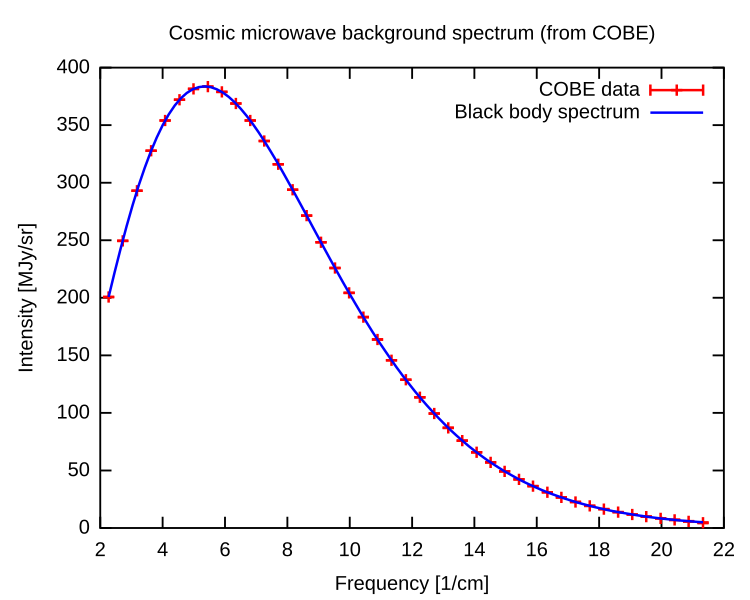
Caption: The nearly perfect blackbody spectrum (plot in the frequency representation (x_max = hν/(kT) = 2.821439372122078893... , F(x_max) ≅ 0.365)) of the cosmic microwave background (CMB) from the Cosmic Background Explorer (COBE, 1989--1993).
Currently, the best result for CMB Temperature T = 2.72548(57) K (Fixsen 2009).
Features:
- The continuous curve is a
fitted blackbody spectrum.
The actual error bars are too small
to be seen. Crosses are put just to show where the
data points are.
- The plot
is of
specific intensity
(in the frequency representation
(x_max = hν/(kT) = 2.821439372122078893... , F(x_max) ≅ 0.365))
versus
wavenumber (with units cm**(-1)).
Note,
frequency representation means
∼ 36.5% of the energy is blueward
of the maximum
and ∼ 63.5 % of the energy is redward
of the maximum.
Wavenumber is inverse wavelength measured in this case in inverse centimeters. It is also frequency divided by the vacuum light speed 2.99792458*10**10 cm/s, and so it is actually a frequency. Wavenumber is given by the formula
νwavenumber = 1/λ = f/c .
- The microwave band (fiducial range 0.1--100 cm)
corresponds to wavenumber range 0.01--10 cm**(-1).
So the CMB
is centered in the microwave band though it extends
significantly to larger wavenumber
(i.e., shorter wavelength) than the
fiducial range of the microwave band
(as the plot shows)
and probably a bit to
smaller wavenumber
(i.e., larger wavelength) than the
fiducial range of the microwave band.
- Why microwaves are called
microwaves when they are of order
centimeters in wavelength is beyond
yours truly.
They should be called CENTIWAVES. But no one ever listens to
yours truly.
- The CMB
is one of the most perfect
blackbody spectra to be found
in nature.
Thus, it corresponds to nearly a single
temperature.
- Currently,
the best result for
CMB Temperature T = 2.72548(57) K (Fixsen 2009)
(see also
Wikipedia:
Cosmic microwave background radiation: Features).
-
Wien's law for
wavenumber
(with units cm**(-1))
and intensity (energy/(area*steradian*time*1/length)) is
νwavenumber maximum = (1.96099855 K/cm) * T ,
which for T=2.72548 K gives
νwavenumber maximum = (1.96099855 K/cm)*(2.72548 K) = 5.34466 cm**(-1) .
As far as yours truly can read the plot, the maximum is at ∼ 5.3 cm**(-1), and so the calculation agrees with the plot as far as yours truly can tell.
- The CMB
is one of the strongest evidences for
Big Bang cosmology:
- Big Bang cosmology includes the proposition that
the early expanding universe
had a hot phase where ionized
matter
(by mass fraction ∼ 75% hydrogen
and 25 % helium) was
in thermodynamic equilibrium
with
electromagnetic radiation (EMR)
at a single temperature.
This EMR field was,
of course, a blackbody radiation field
and it is called
the
cosmic background radiation (CBR).
- The expanding universe
cooled
both matter
and the CBR
(still in mutual
thermodynamic equilibrium)
through adiabatic expansion,
and at some point reached the
temperature
and density conditions where
helium and
then hydrogen recombined
with free electrons to form neutral
atoms.
- The
recombination era t = 377,770(3200) y
occurred at
cosmological redshift
z ≅ 1100.
- The loss of free electrons rapidly
changed the expanding universe
from being largely opaque to being nearly transparent
to the CBR.
- The
CBR
at that time
had a temperature of order 3000 K.
- After the
recombination era
the CBR
evolved as an
expanding
photon gas
in the
expanding universe
that only negligibly interacted with matter.
Occasionally, a
photon will
scatter off an free electron
or be absorbed by a
star or
planet, but most of the
photons just stream freely through
space NEVER hitting anything ever.
- Expansion adiabatic cooled
the CBR
while maintaining it as a
blackbody radiation field
even though it was NOT interacting with
matter.
It is a remarkable feature of
an adiabatic cooling
that a
blackbody radiation field
stays a
blackbody radiation field
while cooled.
The current
CBR
temperature
is 2.72548(57) K (see
Wikipedia:
Cosmic microwave background radiation: Features) which makes
the CBR
significant only in and near the
microwave band (fiducial range 0.1--100 cm, 0.01--10 cm**(-1)).
Hence, we call the current
CBR
the
cosmic microwave background (CMB).
- Despite a lot of ingenuity, no one has thought any natural
(i.e., non-ad-hoc) way of
creating the CMB
in an expanding universe
other than in
Big Bang cosmology.
Thus, the CMB as aforesaid is strong evidence for Big Bang cosmology.
The complete evidence for Big Bang cosmology is quite convincing.
It would be astonishing if it were just plain wrong.
- Big Bang cosmology includes the proposition that
the early expanding universe
had a hot phase where ionized
matter
(by mass fraction ∼ 75% hydrogen
and 25 % helium) was
in thermodynamic equilibrium
with
electromagnetic radiation (EMR)
at a single temperature.
This EMR field was,
of course, a blackbody radiation field
and it is called
the
cosmic background radiation (CBR).
Image link: Wikimedia Commons: File:Cmbr.svg.
Local file: local link: cmb.html.
File: Cosmology file: cmb.html.